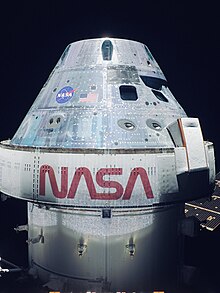Orion (spacecraft)
American–European spacecraft class for the Artemis program / From Wikipedia, the free encyclopedia
Dear Wikiwand AI, let's keep it short by simply answering these key questions:
Can you list the top facts and stats about Orion spacecraft?
Summarize this article for a 10 years old
Orion (officially Orion Multi-Purpose Crew Vehicle or Orion MPCV) is a partially reusable crewed spacecraft used in NASA's Artemis program. The spacecraft consists of a Crew Module (CM) space capsule designed by Lockheed Martin and the European Service Module (ESM) manufactured by Airbus Defence and Space. Capable of supporting a crew of six beyond low Earth orbit, Orion can last up to 21 days undocked and up to six months docked. It is equipped with solar panels, an automated docking system, and glass cockpit interfaces modeled after those used in the Boeing 787 Dreamliner. A single AJ10 engine provides the spacecraft's primary propulsion, while eight R-4D-11 engines, and six pods of custom reaction control system engines developed by Airbus, provide the spacecraft's secondary propulsion. Although compatible with other launch vehicles, Orion is primarily intended to launch atop a Space Launch System (SLS) rocket, with a tower launch escape system.
 Photo of Orion taken during the flight of Artemis 1 | |
| Manufacturer | |
|---|---|
| Operator | NASA[1] |
| Applications | Crewed exploration beyond LEO[2] |
| Project cost | US$21.5 billion nominal ($26.3 billion inflation adjusted to 2022) |
| Specifications | |
| Spacecraft type | Crewed |
| Launch mass |
|
| Dry mass |
|
| Payload capacity | 220 lb (100 kg) return payload |
| Crew capacity | 2–6[3] |
| Volume |
|
| Power | Solar |
| Regime | Lunar Transfer Orbit, lunar orbit |
| Design life | 21.1 days[5] |
| Dimensions | |
| Length | 10 feet 10 inches (3.30 m) |
| Diameter | 16 feet 6 inches (5.03 m) |
| Production | |
| Status | In service |
| On order | 6–12 (+3 ordered before 2019) [6] |
| Built | 4 |
| Launched | 2 |
| Maiden launch | December 5, 2014 |
| Related spacecraft | |
| Derived from | |
 | |
Orion was originally conceived in the early 2000s by Lockheed Martin as a proposal for the Crew Exploration Vehicle (CEV) to be used in NASA's Constellation program. Lockheed Martin's proposal defeated a competing proposal by Northrop Grumman and was selected by NASA in 2006 to be the CEV. Originally designed with a service module featuring a new "Orion Main Engine" and a pair of circular solar panels, the spacecraft was to be launched atop the Ares I rocket. Following the cancellation of the Constellation program in 2010, Orion was heavily redesigned for use in NASA's Journey to Mars initiative; later named Moon to Mars. The SLS replaced the Ares I as Orion's primary launch vehicle, and the service module was replaced with a design based on the European Space Agency's Automated Transfer Vehicle. A development version of Orion's CM was launched in 2014 during Exploration Flight Test-1, while at least four test articles have been produced. Orion was primarily designed by Lockheed Martin Space Systems in Littleton, Colorado. As of 2022[update], three flight-worthy Orion spacecraft are under construction, with one completed and an additional one ordered,[lower-alpha 1] for use in NASA's Artemis program.
The first completed unit, CM-002, was launched on November 16, 2022 on Artemis 1.[9][10][11]